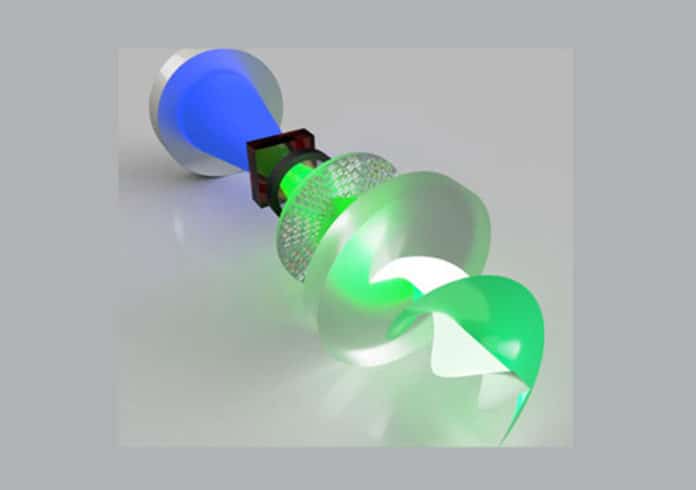Scientists in collaboration have developed the world’s first metasurface laser that produces “super-chiral light”- the light with ultra-high angular momentum. Also, they have developed a nanostructured metasurface that has the most significant phase gradient ever produced and allows for high power operation in a compact design.
This super-chiral light can be used as a type of “optical spanner” to or for encoding information in optical communications.
Professor Andrew Forbes, from the School of Physics at the University of the Witwatersrand (Wits) in Johannesburg, South Africa, said, “Because light can carry angular momentum, it means that this can be transferred to matter. The more angular momentum light carries, the more it can transfer. So you can think of light as an ‘optical spanner.’ Instead of using a physical spanner to twist things (like screwing nuts), you can now shine a light on the nut, and it will tighten itself.”
The study is conducted in collaboration between Wits University and the Council for Scientific and Industrial Research (CSIR) in South Africa, Harvard University (USA), the National University of Singapore (Singapore), Vrije Universiteit Brussel (Belgium) and CNST—Fondazione Istituto Italiano di Tecnologia Via Giovanni Pascoli (Italy).
In this study, scientists devised a laser that emits any desired chiral state of light, with full control over both angular momentum (AM) components of light, the spin (polarization), and orbital angular momentum (OAM) of light.
The laser design is made possible by the complete control offered by new nanometer-sized (1000 times smaller than the width of a human hair) metasurface—designed by the Harvard group—within the laser. The metasurface is made up of many tiny rods of nanomaterial, which alters the light as it passes through. The light passes through the metasurface many times, receiving a new twist every time it does so.
Professor Andrew Forbes from the School of Physics at the University of the Witwatersrand (Wits) in Johannesburg, South Africa said, “What makes it special is that to the light, the material has properties impossible to find in Nature, and so is called a “metamaterial”—a make-believe material. Because the structures were so small, they appear only on the surface to make a metasurface.”
“The result is the generation of new forms of chiral light not observed from lasers until now, and complete control of light’s chirality at the source, closing an open challenge.”
“There is a strong drive at the moment to try and control chiral matter with twisted light, and for this to work, you need a light with a very high twist: super-chiral light.”
“We can use this type of light to drive gears optically where physical-mechanical systems would not work, such as in micro-fluidic systems to drive flow. Using this example, the goal is to perform medicine on a chip rather than in a large lab and is popularly called Lab-on-a-Chip. Because everything is small, light is used for the control: to move things around and sort things, such as good and bad cells. Twisted light is used to drive micro-gears to get the flow going, and to mimic centrifuges with light.”
“Controlling light’s chirality at the source is a challenging task and highly topical because of the many applications that require it, from optical control of chiral matter to metrology, to communications. Complete chiral control implies control of the full angular momentum of light, polarisation, and OAM.”
The metasurface gives laser an unprecedented “twist” in its phase as well as controlling the polarisation. By arbitrary angular momentum control, the standard spin-orbit symmetry could be broke, for the first laser to deliver full angular momentum control of light at the source.
The resulting laser could lase on OAM states of 10 and 100 simultaneously for the highest reported AM from a laser to date. In the particular case that the metasurface is set to produce symmetric states, the laser then creates all earlier OAM states revealed from specially organized light lasers.
Forbes said, “What we find particularly exciting is that our approach lends itself to many laser architectures. For instance, we could increase the gain volume and metasurface size to produce a bulk laser for high-power, or we could shrink the system down onto a chip using a monolithic metasurface design.”
“In both cases, the lasing mode would be controlled by the pump’s polarisation, requiring no intra-cavity elements other than the metasurface itself. Our work represents an important step towards merging the research in bulk lasers with that of on-chip devices.”
Journal Reference:
- Hend Sroor, High-purity orbital angular momentum states from a visible metasurface laser. DOI: 10.1038/s41566-020-0623-z
